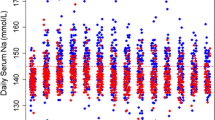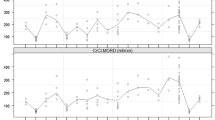Abstract
Background: Traumatic brain injury (TBI) is a common disease accompanied by chronic morbidity and mortality. The pathological mechanism and effective pharmacological treatments of TBI remain undetermined. It is suggested that AVP is involved in TBI. It is thus interesting to investigate the changes and effects of plasma AVP in clinical trials. Methods: The serum concentrations of AVP, serum electrolytes, and serum osmolarity in a total of 23 TBI patients were dynamically monitored (on admission, Day 1, Day 3, and Day 5). Relationship between AVP and severity of brain injury and functional outcome were evaluated, respectively. Results: The mean AVP serum concentrations in the TBI group were significantly higher than those recorded in the control (CTRL) group on intensive care unit (ICU) admission and Day 1 (p<0.05). On Day 3 and Day 5, the differences between those groups were not significant (p>0.05). The negative correlations were found between sodium and AVP (r=− 0.35; p<0.05) and between osmolarity and AVP (r=− 0.42; p<0.05). In poor outcome group, the mean AVP serum concentrations were significantly higher than in good outcome group and CTRL group (p<0.05). A statistically significant correlation was also found between AVP on ICU admission and the initial Glasgow Coma Scale (r=0.47; p<0.05). Conclusion: We suggest that AVP is involved in the pathophysiology process of secondary brain damage after TBI. It seems that AVP antagonist is a promising target for the treatment of TBI, while further studies should be carried out.
Similar content being viewed by others
References
Schneider HJ, Kreitschmann-Andermahr I, Ghigo E, Stalla GK, Agha A. Hypothalamopituitary dysfunction following traumatic brain injury and aneurysmal subarachnoid hemorrhage: a systematic review. JAMA 2007, 298: 1429–38.
Rothman MS, Arciniegas DB, Filley CM, Wierman ME. The neuroendocrine effects of traumatic brain injury. J Neuropsychiatry Clin Neurosci 2007, 19: 363–72.
Buijs RM. Intra- and extrahypothalamic vasopressin and oxytocin pathways in the rat: pathways to the limbic system, medulla oblongata and spinal cord. Cell Tissue Res 1978, 192: 423–35.
Robinson IC. Neurohypophysial peptides in cerebrospinal fluid. Prog Brain Res 1983, 60: 129–45.
Hertz L, Chen Y, Spatz M. Involvement of non-neuronal brain cells in AVP-mediated regulation of water space at the cellular, organ, and whole-body level. J Neurosci Res 2000, 62: 480–90.
Simard M, Nedergaard M. The neurobiology of glia in the context of water and ion homeostasis. Neuroscience 2004, 129: 877–96.
Armstead WM. Role of endothelin in pial artery vasoconstriction and altered responses to vasopressin after brain injury. J Neurosurg 1996,85: 901–7.
Fernández N, Martínez MA, García-Villalón AL, Monge L, Diéguez G. Cerebral vasoconstriction produced by vasopressin in conscious goats: role of vasopressin V1 and V2 receptors and nitric oxide. Br J Pharmacol 2001, 132: 1837–44.
Thibonnier M, Coles P, Thibonnier A, Shoham M. Molecular pharmacology and modeling of vasopressin receptors. Prog Brain Res 2002, 139: 179–96.
Hösli L, Hösli E, Lefkovits M, Wagner S. Electrophysiological evidence for the existence of receptors for endothelin and vasopressin on cultured astrocytes of rat spinal cord and brain stem. Neurosci Lett 1991, 131: 193–5.
Armstead WM. Vasopressin-induced protein kinase C-dependent superoxide generation contributes to atp-sensitive potassium channel but not calcium-sensitive potassium channel function impairment after brain injury. Stroke 2001, 32: 1408–14.
Isotani E, Suzuki R, Tomita K, et al. Alteration in plasma concentration of natriuretic peptides and antidiuretic hormone after Subarachnoid hemorrhage. Stroke 1994, 25: 2198–203.
Jochberger S, Mayr VD, Luckner G, et al. Serum vasopressin concentrations in critically ill patients. Crit Care Med 2006, 34: 293–9.
Westermann I, Dünser MW, Haas T, et al. Endogenous vasopressin and copeptin response in multiple trauma patients. Shock 2007, 28: 644–9.
Huang WD, Yang YM, Wu SD. Early changes of arginine vasopressin and angiotensin in patients with acute cerebral injury. Chin J Traumatol 2001,4: 161–3.
Teasdale G, Jennett B. Assessment of coma and impaired consciousness. A practical scale. Lancet 1974, 2: 81–4.
Jennett B, Bond M. Assessment of outcome after severe brain damage. Lancet 1975, 1: 480–4.
Johanson CE, Preston JE, Chodobski A, Stopa EG, Szmydynger-Chodobska J, McMillan PN. AVP V1 receptor-mediated decrease in Clefflux and increase in dark cell number in choroid plexus epithelium. Am J Physiol 1999, 276: C82–90.
Szmydynger-Chodobska J, Chung I, Kozniewska E, et al. Increased expression of vasopressin V1a receptors after traumatic brain injury. J Neurotrauma 2004, 21: 1090–102.
Sarfaraz D, Fraser CL Effects of arginine vasopressin on cell volume regulation in brain astrocyte in culture. Am J Physiol 1999, 276: E596–601.
Raichle ME, Grubb RL Jr. Regulation of brain water permeability by centrally-released vasopressin. Brain Res 1978, 143: 191–4.
Dóczi T, Szerdahelyi P, Gulya K, Kiss J. Brain water accumulation after the central administration of vasopressin. Neurosurgery 1982, 11: 402–7.
László FA, Varga C, Dóczi T. Cerebral edema after subarachnoid hemorrhage. Pathogenetic significance of vasopressin. Acta Neurochir (Wien) 1995, 133: 122–33.
Reeder RF, Nattie EE, North WG. Effect of vasopressin on cold-induced brain edema. J Neurosurg 1986, 64: 941–50.
O’Donnell ME, Duong V, Suvatne J, Foroutan S, Johnson DM. Arginine vasopressin stimulation of cerebral microvascular endothelial cell Na-K-Cl cotransporter activity is V1 receptor and [Ca] dependent. Am J Physiol Cell Physiol 2005, 289: C283–92.
Gunnarson E, Zelenina M, Aperia A. Regulation of brain aquaporins. Neuroscience 2004, 129: 947–55.
Lluch S, Conde MV, Diéguez G, et al. Evidence forthe direct effect of vasopressin on human and goat cerebral arteries. J Pharmacol Exp Ther 1984, 228: 749–55.
Ikeda Y, Toda S, Kawamoto T, Teramoto A. Arginine vasopressin release inhibitor ru51599 attenuates brian oedema following transient forebrain ischaemia in rats. Acta Neurochir (Wien) 1997,139: 1166–72.
Shuaib A, Xu Wang C, Yang T, Noor R. Effects of nonpeptide V(1) vasopressin receptor antagonist SR-49059 on infarction volume and recovery of function in a focal embolic stroke model. Stroke 2002, 33: 3033–7.
Author information
Authors and Affiliations
Corresponding author
Rights and permissions
About this article
Cite this article
Huang, W.D., Pan, J., Xu, M. et al. Changes and effects of plasma arginine vasopressin in traumatic brain injury. J Endocrinol Invest 31, 996–1000 (2008). https://doi.org/10.1007/BF03345638
Accepted:
Published:
Issue Date:
DOI: https://doi.org/10.1007/BF03345638




